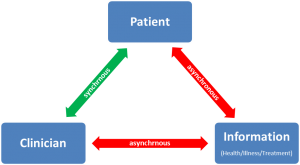Debate @trainee_conf_14 Will advancing technology support or destroy thre patient-professional relationship? pic.twitter.com/DBP5ODXzkK
— Dr Marisa Dias (@MarisaCDias) November 26, 2014
Debate @trainee_conf_14 Will advancing technology support or destroy thre patient-professional relationship? pic.twitter.com/DBP5ODXzkK
— Dr Marisa Dias (@MarisaCDias) November 26, 2014
Last week I was invited to be on the panel for a lively debate on this thought-provoking question. I like such questions as they force us take a step back and look at the big picture gradually unfolding around us. Such questions make great topics for open ended debates, which the orgnaisers 1I have been attending this annual conference for a few years now and it has always been superbly organised. In fact it is betting even better with each passing year as its organisers (who are trainees themselves) are becoming bolder and ambitious in their vision. I want to congratulate the organisers of Mind, Body, Spirit: Psychiatry in Context 2014 Conference for a thoughtful agenda, smooth coordination and flawless execution. made sure it was (kudos!). Both the topic and the surrounding cricket memorabilia on display at Kia Oval, where it was hosted, enthused the audience and we fielded some very interesting questions and comments from them. In the end one hour was not enough to take every question on board, but I have noted the one’s that were asked and planning to pen down a few blog posts here to discuss those in detail. As it was the annual conference of London Specialty School of Psychiatry Annual Trainee Conference, there were hundreds of enthusiastic young psychiatrists in the audience. It was interesting to note that while the senior psychiatrists 2Many thanks to Dr Michael Maier in front row, who alerted me just in time about the precarious position my chair found itself in (with one leg halfway off the stage) while I was delivering my opening statement. That fall would have made a more spectacular sight to tweet than the routine image I have included above. in attendance focused on perceived usefulness of modern technology, the younger generation asked questions pertaining to the management of available technology. I have talked about such a split between pre-adoption and post-adoption generations in past, but it was interesting to see it playing out in reality in such a large crowd. My fellow panel members, who were Richard Graham (Consultant Psychiatrist, Technology Addiction), Alex Langford 3Alex has shared his thoughts on the issue before the debate on his popular blog. (Blogger), André Tomlin (The Mental Elf) and Mark Brown (One in Four) freely shared their insights and nuggets from their own experience. The fun of having open ended debates is mostly in the ability to accommodate a rich diversity of viewpoints, which was clearly evident in the opening statements of each of the panel member. Everyone had a different angle on the question, but the message remained the same – we should try and understand the process of technological change in order to use it to be even better clinician tomorrow.
I think that it would be useful to save my opening statement for this debate here for an “internet peer-review” and may be for the sake of posterity. Maybe I can revisit this page after a few years to compare notes with the reality of tomorrow.
Here is complete text of my opening statement at Mind, Body, Spirit: Psychiatry in Context. 26th November 2014:
I am a medical psychotherapist by training. One thing I have learned well is that relationships are not set in stone. Although bound by some basic rules, all relationships evolve to become something better or worse. They are always in a constant state of flux. People change and so do their relationships. Time changes, so do the relationships that exist in that time period. Society changes and so do the relationships living in that society. Doctor-patient relationship is not an exception. It is changing and evolving as we speak. We don’t know yet whether it is for good or bad.
Technology has brought information on our finger tips. A therapist can no longer be a blank slate to the patient as he has been trained to be. Thanks to social networking, patients now know who you are, what your interests are and what is your friend circle like. Is this a good thing or a bad thing? Would it limit my choices of the model of therapy that I can use? I don’t know. What I do know is that the rules are different now, and I have to get a better sense of it before I can do what I want to do, that is to help a patient become better. Even if it means rewriting the rules of my practice, which were framed in a different time and generation, I should be open to it. It should not mean that I exclude myself from the benefits of technology and the connectedness it brings. Avoidance is not an option – that’s what we tell our patients in cognitive behavioral therapy. I believe that we should adopt this change and adapt. I believe that by harnessing this shift we can be better doctors and create more meaningful relationships with even greater number of patients. It might sound a bit like the proverbial dream of a manager in NHS, but it certainly is achievable.
First shift should be a shift in our perceptions of what doctor-patient relationship is. In actual terms terms it is a partnership to solve a problem. To efficiently solve the problem both parties have to collaborate and exchange information. However unlike historical archetypes, doctor is no longer the primary information provider to patients. The barriers to access information have fallen so low in last two decades that anyone with an internet connection can get more information about their symptoms than the doctor they are planning to see. We are no longer the expert, internet has reduced us to a generalist who knows a fair bit about everything. The balance of information power has tilted in favour of the patients. In turn our relationship with them has inverted, at least in certain dimensions of knowledge. Gradually this would change how we are perceived by public. In future we, as doctors, might be valued more for our skills and experience than for our knowledge. Not a popular thing to say to an audience which is full of trainees who are just starting on a journey of a lifetime of experience, but it looks likely to happen in near future. IBM, the oldest information technology corporation, has developed a software solution aptly named as Watson after the famous Dr Watson in the novels of Sir Arthur Conan Doyle. This new age Watson is “training” to be a doctor, hold your breath, a specialist doctor in all known disciplines of modern medicine. It would be able to learn more than we ever can. It would be able to update its knowledge in real time, a feat impossible for anyone of us in this day and age of information explosion.
I took time to say yes to the invitation for today’s debate. I needed time to think whether I have something meaningful to say on the topic. The more I thought, the more I realised that it is a question with multiple layers. At its heart it is asking are today’s doctors disposable in future. Is our profession, one of the oldest professions in history, actually just a temporary solution to a necessity we have as a society. Would technology replace us eventually? I don’t know what would happen after 100 years, but in our lifetime the answer would be no. On the contrary we are sitting on the cusp of a information revolution 4I did notice some raised eyebrows in audience at this point and wondered if some people still underestimate the changes happening around us. in doctor-patient relationship. If we design the right tools, if we understand the changes, if we consider patient to be an expert in their problem and ourselves as an expert in delivering the solution, if we allow doctor-patient relationship to evolve with the demands of time, then yes we have the biggest opportunity right in front of us.
footnotes
| ↑1 | I have been attending this annual conference for a few years now and it has always been superbly organised. In fact it is betting even better with each passing year as its organisers (who are trainees themselves) are becoming bolder and ambitious in their vision. I want to congratulate the organisers of Mind, Body, Spirit: Psychiatry in Context 2014 Conference for a thoughtful agenda, smooth coordination and flawless execution. |
|---|---|
| ↑2 | Many thanks to Dr Michael Maier in front row, who alerted me just in time about the precarious position my chair found itself in (with one leg halfway off the stage) while I was delivering my opening statement. That fall would have made a more spectacular sight to tweet than the routine image I have included above. |
| ↑3 | Alex has shared his thoughts on the issue before the debate on his popular blog. |
| ↑4 | I did notice some raised eyebrows in audience at this point and wondered if some people still underestimate the changes happening around us. |

